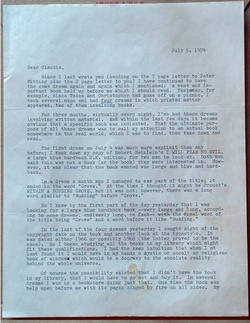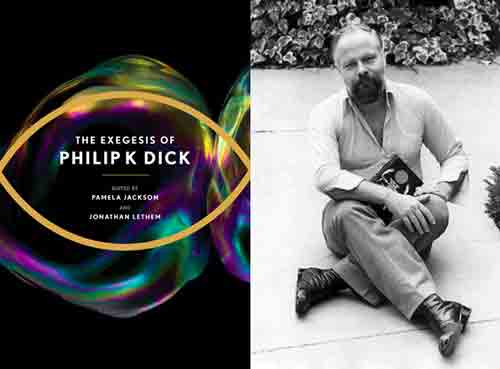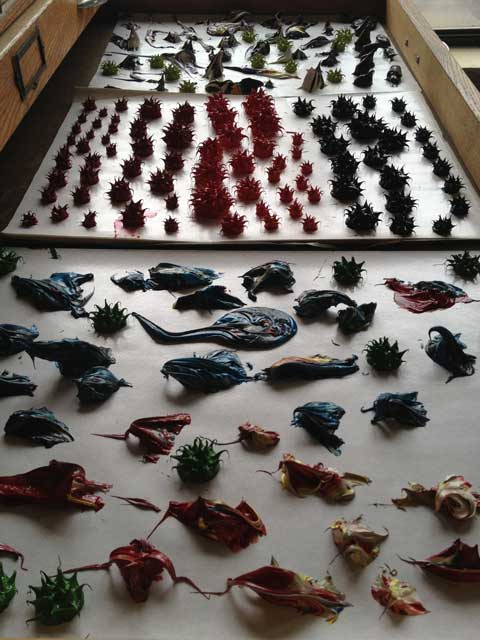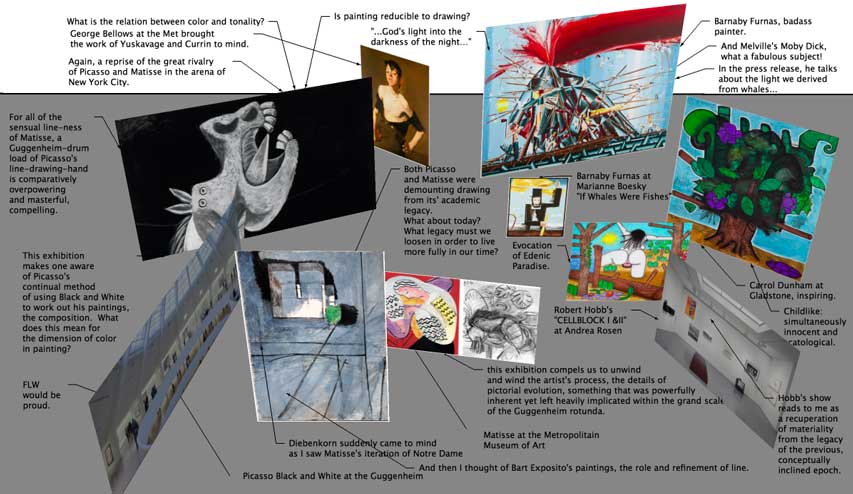December 25, 2012
Scrapbook: Klein Via Vreeland
Tracing backwards in the stream of my encounters, from William Klein to a movie that Stephanie and I watched recently, Diana Vreeland - The Eye Has To Travel. We caught a glimpse of Klein's work in the Vreeland biopic and jumped down the bunny hole as soon as we got home. My only question at this point is if William Klein's work was a parody of the fashion industry and politics, then did the biographers think that the parody had shone an informative light on the character of Diana Vreeland?
Obviously so.
So, what of the veracity of Klein's critique of aesthetics/consumer culture/"Imperialism", then?
Further down the bunny hole, we sight Marc Jacobs (who is referencing Edie Sedgwick), and into this game, I threw down the card of Daniel Buren, I wikisnip:
...he had abandoned traditional painting for the vertical stripes (8.7 cm wide, alternating between white and a color), which have become his signature. Working on site, he strives to contextualise his artistic practice using the stripe - a popular French fabric motif - a means of visually relating art to its situation, a form of language in space rather than a space in itself. Denoting the trademark stripes as a visual instrument or �seeing tool� he invites us to take up his critical standpoint challenging traditional ideas about art. He began producing unsolicited public art works using striped awning canvas common in France: he started by setting up hundreds of striped posters, so-called affichages sauvages, around Paris and later in more than 100 metro station stations, drawing public attention through these unauthorised bandit style acts. In June 1970 he put stripes on the front and back of Los Angeles bus benches without permission. In another controversial gesture he blocked the entrance of the gallery with stripes at his first solo exhibition....
December 21, 2012
test

There's trouble in River City. I'm trying to figure out why I can't upload certain images and can others.
Painters Painting
Scientists are trying to model the human brain. See more at Spaun brain activity.
This blogpost is a recursion to the recursive themes that I've blogged about recently (Gary Geck, Kurt G?del, P.K.Dick).
Your brain is an nth level recursion as you watch these videos.
About Spain
Here is an informative documentary from the BBC's Paul Mason about the recent history of Spain.
(Let's jump to the conclusion: Spain has to leave the Euro ASAP.)
December 16, 2012
Ann Hamilton at the Armory

Walking down Lexington last night, we were pleasantly surprised by a back door view of Ann Hamilton's installation at the Park Avenue Armory, titled "the event of a thread", a huge veil animated by a number of swings of which the public are invited to engage. (December 5, 2012 - january 6, 2013)
(Animated gifs via LoopCam.)
I took the opportunity to shoot a couple of panoramas of the Armory's magnificent interior:
December 14, 2012
December 9, 2012
Recursive Rider: Sophie Blackall

Above: a second level recursion.
When the NYC weather is inclement, I park the scooter and take the subway to the studio. On one particular series of days, I was listening to PKD's Exegesis, then to Gary Geck on Kurt G?del, then to the lads at the Partially Examined Life to refresh myself on the episodes on Kant and Husserl, because G?del made me want to.
As all this was happening, I began to regard with appreciation, the recursive theme in Sophie Blackall's artwork that banner the subway interior.
Andrew Hahn Studio Winter 2012
Andrew sent me these pics of his current work, a few snapshots of his studio in Los Angeles. I call it the Crystal Palace/the Crystal Library. Plexi-architecture. Columns of framed prints. Editions of pirate prints. Among these and other projects, he's been printing, binding and otherwise fashioning books using xerox transfers, ultra unique editions.Here are a couple of pop up images to still a couple of frames from the animated gif above:
December 7, 2012
How Do You Know When You're Done?
A few weeks ago, painter and documentarian Jeffrey Collins visited my studio. We met on FaceBook a while back and I discovered that he was working on a film project patterned on the famous Painters Painting, "Who's Afraid of Red Yellow and Blue?", for which I cheered him on.
I was surprised and honored that he wanted to include me in his lineup. So on our first encounter in my Brooklyn, he arrived with a suitcase of cameras and tape recorders, we sat down and he asked me a list of questions and shot my replies.
"How do you know when you are done?"
It's a question that appears like Haley's Comet, you know you will hear it again someday.
The completion question is uniquely indicative of abstraction since in representation, the achievement of likeness seems to answer the question before it's asked. It only seems to because verisimilitude occludes the ultimate question of compositional strategy for the average viewer. In non objective painting (an alternate nomination for abstraction, although it doesn't mean exactly the same thing), movement toward completion primarily involves balance whether this is defined by the equilibrium of compositional elements --no matter how dynamic the painting is-- or if it's defined by capture and corralling the eye within the bounds of the canvas.
In trying to answer the question with earnestness, I'm ignoring my grad school training. Artists are advised to answer questions like that in the manner of Andy Warhol. "Oh, for heaven's sake!" One could say with a teasingly enigmatic smile. "Why would you ever want to be done?" At its heart, this is a political strategy. It's also fundamentally cynical because it could be used hide the possibility that a straight answer might be able to foreclose the mystery that lies at the core of art.
For my painting, this question is doubly pertinent since I position myself precisely between abstraction and representation. I believe that there are enough flags planted on the north pole of abstraction and on the south pole of representation (or should the polar assignation be reversed? It depends on your bias for abstraction, representation and cultural hemispheres north or south). Consider the bodies littering Mt. Everest. After Edmund Hillary and Tenzing Norgay, every subsequent expedition renders a diminishing and increasingly inverted significance. After the existence of the poles have been established, it would be wise to use the insights gleaned and construct a compass out of it. The globe thusly apprehended is the world of painting itself. And what does one do with a compass? You explore the world. You sail the seas.
Degrees of latitude above and below the equator. Between.
How do you know that you are done? When you have discovered someplace hitherto unknown.
Well, that's one way to answer this question. As for my reply in the video, when I mentioned the infinitesimal, I was thinking of calculus and Leibniz. I'll have to drop a few more veils from that mystery in future blogpost.
***
By the way, Jeffrey will be showing his work at the Sideshow Gallery at 319 Bedford Ave in Brooklyn this coming January 5th.
***
December 6, 2012
December 3, 2012
Who is Claudia Bush?


A few notes regarding my latest audiobook adventures:
Like Abraham Lincoln: A Life and The Power Broker: Robert Moses and the Fall of New York, my latest audiobook adventure is a huge multivolume of an immersion into another epic topic.
Via Audible, The Exegesis of Philip K. Dick. As per my recent visit to Leibniz-land, Gary Geck's Neo-Platonic thread led me to PKD's Exegesis. (Another GG fun fact: Leibniz actually did propose an idea for a theme park, interesting, right?)
PKD was endowed with a uniquely acute sensibility and capacity to isolate and process those subtle subjective psychological dissonances which occur from time to time in life (and everyone should be familiar with this, but few isolate and analyze these feelings), sensations such as deja-vu, dreams, for example, and he uses a vast knowledge base (which curiously the foundation of which was the encyclopedia Britannica and Paul Edwards?s eight volume ?Encyclopedia of Philosophy?, see this) to roughly weave strands of rationality and imagination in the service of art, braiding story telling architectures.
I listen to audiobooks and podcasts as I ride my commute to the studio and there was a particular passage where I had to pull over to rewind -twice- and replay the section where he was revealing to Claudia Bush, his creative process. He was explicit and open and succinct. He was showing her how he ported his life (and this is the sensibility thing: at the base of it all was a hyper, acute awareness of the flow of his mental/physical states) into an idea, into a plot, into a novel.
What I'm getting so far as a reader/ listener of PKD's Exegesis, is a close and intimate view of his one of a kind creative process and world view (the two are inseparable). I'm beginning to see his work as ultimately an allegory about the creative process itself, a self portrait of imagination. I'm also reminded of Robert Smithson, with all of the references to entropy and negentropy, in which, as far as I understand Neo-Platonism, the latter is enfolded -hidden?- within the former... and this reveals to me a possible aspect of Smithson's attraction to the topic in terms of art (creation within degradation).










